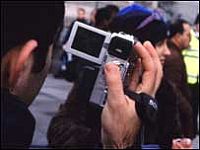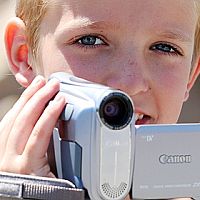- About Us
- Columns
- Letters
- Cartoons
- The Udder Limits
- Archives
- Ezy Reading Archive
- 2024 Cud Archives
- 2023 Cud Archives
- 2022 Cud Archives
- 2021 Cud Archives
- 2020 Cud Archives
- 2015-2019
- 2010-2014
- 2004-2009
 |
The New TV Aesthetic: What YouTube Teaches Screenwriters |
Consider Everybody Loves Raymond. It is predominantly set in two rooms, over-lit to oblivion to minimise set up time and often has single scenes that span the time between ad breaks — all in that one living room.
 It positively embodies the sitcom format; some might even say it perfected it.
It positively embodies the sitcom format; some might even say it perfected it.
Now… Consider popular scripted YouTube content. It has a DV look about it (because most of it is shot with DV), it is 'poorly' lit — though personally I like the handycam/webcam look — and very rarely follows a classic three act structure.
All of this has been learned from User Generated Content. This is the secret that the online video revolution has offered us: sure, a lot of the videos out there amount to little more than college pranks or disturbed cats misbehaving but this is not the future of online video.
Rather, this is a direct indication from our audience that this is the screen language they want us to speak to them in. It sounds so simple but it is worth pointing out: there is a reason that the 12-24 age bracket is leaving broadcast television. What they find there does not appeal to them. They do not want procedural crime drama and they certainly do not care that you went to film school.
Aesthetic 1: Immediacy
Scenes don't need to be perfectly balanced, numerous takes are not required. It's okay if it looks a little rough around the edges as long as it feels 'immediate' or — dare I say — unscripted?
 Close ups, handheld, it's all back on the cards. (But if you go Blair Witch on me I WILL find you. Seriously.)
Close ups, handheld, it's all back on the cards. (But if you go Blair Witch on me I WILL find you. Seriously.)
Aesthetic 2: Story Quality
How is story quality an aesthetic? By completely removing your ability to hide behind the 'filmic' quality of celluloid with its forgiven blurriness and soft colours that someone will no doubt claim are deliberate. No more over-cranking the Arri and pointing it at some Autumn leaves.
God. Bless. DV. YouTube teaches us that good content becomes popular. The rough edges are forgiven but being indulgent or pointless is not.
By the same token you cannot hide behind words like 'format' or 'genre' to excuse a rocky start or a contrived ending. The story has to be good to find an audience. Period.
Aesthetic 3: Unstructure
You know all those rules about the first page and quickly getting to your protagonist and his/her inciting incident? Focus on the cat instead.
This aesthetic needs some common sense applied to it, of course, or otherwise you end up with impenetrable grad student mush.
Screenwritings rules are built around an established economic model — we need ad breaks on television, we owe movie-goers certain things for their twelve bucks — that  currently do not exist for online video. These rules are exactly what the new audience has rejected. They are bored with them. So try something new! Maybe crack out some of those short film scripts from your first year at college.
currently do not exist for online video. These rules are exactly what the new audience has rejected. They are bored with them. So try something new! Maybe crack out some of those short film scripts from your first year at college.
Maybe not.
Aesthetic 4: Serialisation
This is my absolute favourite thing that YouTube teaches us: Online video is a dialogue with your audience. Keep it going! The most popular online series have been just that; a series! A sequence of open-ended vignettes that completely lacks a pre-determined end point.
You don't have to write 4 fifteen minute episodes or squeeze all that story into an eleven minute short. Find a character and stick with him/her for as long as you want -or until you kill her as was the case with Lonely Girl 15.
Conclusion
There are plenty more things we can learn from YouTube and user generated content when it comes to screenwriting for the web. These four aesthetic observations are designed to get you excited about the creative freedom this format offers.
I will sound a note of caution here, however. You are going for 'free' and 'unstructured'. This type  of creating should be a joy. If you approach it from a paint-by-numbers angle; checking off that you shot handheld and rough and 'edgy'; it will feel so contrived that watching it will be like hearing nails on a chalk board. Just have a look at all the appalling attempts MTV and other youth networks have vomited up. Nobody wants that.
of creating should be a joy. If you approach it from a paint-by-numbers angle; checking off that you shot handheld and rough and 'edgy'; it will feel so contrived that watching it will be like hearing nails on a chalk board. Just have a look at all the appalling attempts MTV and other youth networks have vomited up. Nobody wants that.
If you can't 'speak' this language then don't try. Stick with the classic formats. They are classic for a reason. Remember when you were growing up and Dad would try his best at replicating your friends lingo? And remember how it still makes you scream whenever someone mentions it like I just did?
Exactly.
One last tip -and it's an absolute gem- but the easiest and absolute best 'how to' site for getting your videos shot, converted, up onto the web and marketed is Make Internet TV.
Check it out if you are new or not and let's see those stories.
This article is syndicated from smallscreens.org — a new blog designed to help screenwriters navigate new media.
